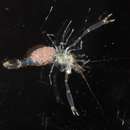pt-BR
nomes no trilho de navegação


The genus Periclimenes, also called anemone shrimps, includes about 175 species, many of which have obligate associations with other, often larger species, but some that are free-living. They live in warm waters, and are especially diverse in reefs of the Indo-West Pacific. Species that Periclimenes shrimp associate with frequently include sea anemones, but they also associate with corals, sponges, crinoids, sea stars, sea cucumbers, urchins, feather stars (crinoids) and sea slugs (nudibranchs).The shrimp gain protection and/or transportation from their host and often keep their hosts’ surfaces clean by eating parasites and dead cells.Some also eat small particles that get stirred up by their host, or eat tentacles or other portions of the host itself.Some species set up “cleaning stations” and leave their host to remove parasites from fish, advertising with stereotypic movements of their long antennae to signal when fish can use their services.These shrimp can be found in the mouths and gills of large fish such as moray eels and groupers.
Anemone shrimps are variously colored, some with bright coloration, some clear or with camouflage coloration that match the species they live with.Many of the hosts are noxious, poisonous, or have stinging tentacles, deterring predators for the shrimp as well as themselves. Some Periclimenes shrimp do well in the aquarium trade, especially those that live on hosts that are easily cultured in tanks.
(Bruce 2004; De Grave and Türkay 2011; Foord 2008; Wikipedia 2013)
Periclimenes, commonly known as glass shrimp or cleaner shrimp, is a commensal and often symbiotic genus of semi-transparent shrimp within the family Palaemonidae.[3][4] Species of this large genus feature a wide variety of coloration and patterns, widespread distribution throughout much of the world's tropical oceans, and are often sought out for aquarium trade.[5]
This genus has undergone several changes in classification based on recent molecular studies comparing species within the genus. However, most recent molecular studies have only involved approximately 20% of the known species likely to belong to the genus. Additionally, most of the molecular studies performed involved Indo-Pacific species of Periclimenes and did not include presumed Periclimenes found in the Atlantic Ocean. Periclimenes has previously been suggested as being a polyphyletic taxa, and has already undergone splits into several new genera. It is likely the genus will undergo changes in classification in coming years with further research.[6]
The genus contains the following species:[7]
Periclimenes is widely distributed throughout tropical and temperate reef ecosystems of the Atlantic, Caribbean, Mediterranean, as well as Indo-Pacific Oceans.[8][9]
Many species of Periclimenes are commensal and often symbiotic organisms within their reef ecosystems. The most common organisms forming symbiotic relationships with this genus are species of fish, cnidarians, echinoderms, and sponges. Some species such as Periclimenes caraibicus have been observed to interact parasitically with species of sponges, living within the sponge and directly eating the sponge tissue. Another species, Periclimenes soror, is commonly found on a species of sea star known as cushion stars with no effect on the star making it a commensalistic relationship. Anecdotal evidence suggests that P. soror may choose a host star that matches its own coloration for camouflage.[10] Other research demonstrated that the Periclimenes species, P. yucatanicus, has a symbiotic cleaning relationship with different species of reef fish studied in the pacific. P. yucatanicus performed a waving motion with its antennae to signal to reef fish that it is available to clean. The cleaner shrimps then ate parasitic organisms present on the reef fish species.[11]
Species present in this genus typically have a transparent to semi transparent body with antennae protruding from the head region. Additionally, large variation of color and patterns exist on the organisms throughout, making them highly sought out ornamental species in the marine aquarium industry.[12]
Periclimenes soror on a pillow starfish Culcita schmideliana.
{{cite journal}}: CS1 maint: multiple names: authors list (link) {{cite journal}}: CS1 maint: multiple names: authors list (link) {{cite journal}}: CS1 maint: multiple names: authors list (link) {{cite journal}}: CS1 maint: multiple names: authors list (link) Periclimenes, commonly known as glass shrimp or cleaner shrimp, is a commensal and often symbiotic genus of semi-transparent shrimp within the family Palaemonidae. Species of this large genus feature a wide variety of coloration and patterns, widespread distribution throughout much of the world's tropical oceans, and are often sought out for aquarium trade.